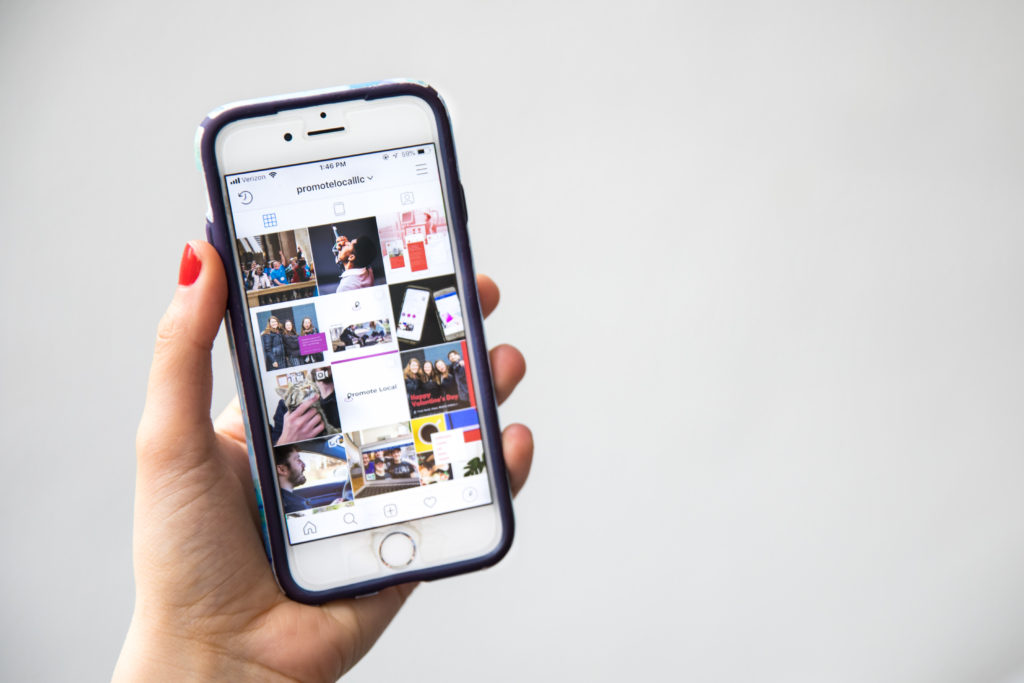Using social media to promote your business is essential to growth marketing. With over a billion monthly active users (more than double the monthly active users of Twitter), Instagram in particular has massive promotional potential, and yet is often overlooked by small businesses. When used correctly, Instagram for business can increase brand awareness and influence, showcase products and services, and drive sales through traffic.
Whether you’re just starting out on Instagram or revamping your strategy, here are our tips for success.
Bio
Your Instagram bio should be short and succinct—who you are and what you do, basically. Promote Local’s bio reads, “We’re a full-stack marketing agency increasing the productivity and overall success of Midwest businesses.”
It’s worth noting that Instagram only lets you use one link in your bio. If you have many different products or services to showcase, one link won’t be enough. In this case, we suggest setting up a Linktree account or a adding landing page on your website. Linktree is a good option if
Linktree Steps:
- Create a Linktree account, and then make this URL your website bio on Instagram
- Add your homepage, www.yourwebsite.com, to your Linktree
- Each time you post a product or service related photo on Instagram, be sure to also add the property URL to your Linktree and direct users to your bio link to learn more
- When someone clicks on your Instagram bio, they will see a nice list of all of the different links you added to Linktree! They can visit your homepage or select a specific property that they saw a photo of on your Instagram feed
Here’s what this looks like:

The other option is to add a mobile-optimized landing page to your website where you can showcase your properties as-seen-on Instagram. This allows you to use your brand’s colors and fonts instead of being stuck with Linktree’s. Additionally, the one link in your profile will be your website URL, allowing visitors to familiarize themselves with it so they remember it and can willingly go back (AKA yourwebsite.com instead of linktr.ee/yourwebsite).
Grid Content
An effective content strategy gives you the needed clarity to create visual content that your target audience will value.
A clearly defined aesthetic is key to a unified brand experience. If you haven’t already established your visual brand guidelines, do this first. This includes the tone of voice you use in captions (professional or casual), as well as your go-to colors, fonts, and even the image subjects. To keep content visually consistent, choose one photo filter to use for all posts. Alternatively, forgo filters altogether—simply adjust each photo’s lighting levels on an individual basis for a more natural aesthetic.
If you’re concerned about others taking and repurposing your original content without permission, watermark each photo with your logo before you post it.
Hashtags
It’s always best to use hashtags to connect with new followers and increase engagement on your posts. These need to be easy to discover, remember, and read.
After posting a photo, copy/paste a previously curated list of hashtags pertaining to your business. These are your general hashtags (e.g. #Marketing).
Before posting these pre-curated hashtags, add a few post-specific hashtags relevant to where and what the particular photo depicts. These are your localized hashtags (e.g. #MadisonMarketing, #MidwestMarketing).
Lastly, include at least one branded hashtag (e.g. #PromoteLocal). Encourage your customers or clients to tag you in photos and include this hashtag. Not only does this give your business great opportunities for user-generated content, it increases brand awareness by encouraging users to participate.
Geotags
Location tagging, or geo-tagging is another way to increase engagement. In fact, posts with a location receive 79% higher engagement than posts without. Geo-tagging allows new users to discover your content through a specific tagged location, and helps you track who’s engaging with a specific location or where your posts are drawing interest.
Stories
- Behind-the-scenes content
- Polls, Q&As
- Live video
- FAQs
Posting Schedule
The main thing is that you show up consistently for your Instagram audience. By following a posting schedule as part of your content plan your audience will rely on you and trust your brand more.
If your business is new to Instagram, start by posting two times per week (e.g. every Monday and Friday). You can increase this amount later as you get the hang of the platform, establish an audience, and begin to gain user-generated content.
Checking Your Progress
Instagram Business Tools provide actionable information about which posts perform best and which days and times are best to post. Use them to see how you’re doing, and adjust your strategy accordingly.
At the end of the day, the most important tip I can give is to strive for engagement, not followers—you must spend engagement to make engagement.

